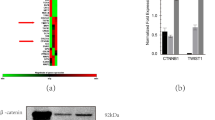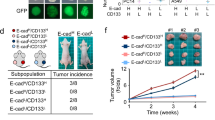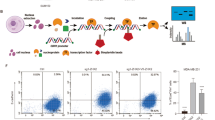Abstract
Epithelial–mesenchymal transition (EMT) is regarded as a crucial contributing factor to cancer progression. Diverse factors have been identified as potent EMT inducers in ovarian cancer. However, molecular mechanism sustaining EMT of ovarian cancer cells remains elusive. Here we show that the presence of SOS1/EPS8/ABI1 complex is critical for sustained EMT traits of ovarian cancer cells. Consistent with the role of SOS1/EPS8/ABI1 complex as a Rac1-specific guanine nucleotide exchange factor, depleting Rac1 results in the loss of most of mesenchymal traits in mesenchymal-like ovarian cancer cells, whereas expressing constitutively active Rac1 leads to EMT in epithelial-like ovarian cancer cells. With the aid of clinically tested inhibitors targeting various EMT-associated signaling pathways, we show that only combined treatment of mitogen-activated extracellular signal-regulated kinase 1/2 (MEK1/2) and Src inhibitors can abolish constitutively active Rac1-led EMT and mesenchymal traits displayed by mesenchymal-like ovarian cancer cells. Further experiments also reveal that EMT can be induced in epithelial-like ovarian cancer cells by co-expressing constitutively active MEK1 and Src rather than either alone. As the activities of Erk and Src are higher in ovarian cancer cells with constitutively active Rac1, we conclude that Rac1 sustains ovarian cancer cell EMT through simultaneous activation of MEK1/2 and Src signaling pathways. Importantly, we demonstrate that combined use of MEK1/2 and Src inhibitors effectively suppresses development of intraperitoneal xenografts and prolongs the survival of ovarian cancer-bearing mice. This study suggests that cocktail of MEK1/2 and Src inhibitors represents an effective therapeutic strategy against ovarian cancer progression.
This is a preview of subscription content, access via your institution
Access options
Subscribe to this journal
Receive 50 print issues and online access
$259.00 per year
only $5.18 per issue
Buy this article
- Purchase on Springer Link
- Instant access to full article PDF
Prices may be subject to local taxes which are calculated during checkout








Similar content being viewed by others
References
Jayson GC, Kohn EC, Kitchener HC, Ledermann JA . Ovarian cancer. Lancet 2014; 384: 1376–1388.
Seward SM, Winer I . Primary debulking surgery and neoadjuvant chemotherapy in the treatment of advanced epithelial ovarian carcinoma. Cancer Metastasis Rev 2015; 34: 5–10.
Thiery JP, Sleeman JP . Complex networks orchestrate epithelial-mesenchymal transitions. Nat Rev Mol Cell Biol. 2006; 7: 131–142.
Thiery JP . Epithelial-mesenchymal transitions in tumour progression. Nat Rev Cancer 2002; 2: 442–454.
Thiery JP, Acloque H, Huang RY, Nieto MA . Epithelial-mesenchymal transitions in development and disease. Cell 2009; 139: 871–890.
Lester RD, Jo M, Montel V, Takimoto S, Gonias SL . uPAR induces epithelial-mesenchymal transition in hypoxic breast cancer cells. J Cell Biol 2007; 178: 425–436.
Yang MH, Wu MZ, Chiou SH, Chen PM, Chang SY, Liu CJ et al. Direct regulation of TWIST by HIF-1alpha promotes metastasis. Nat Cell Biol 2008; 10: 295–305.
Wu Y, Deng J, Rychahou PG, Qiu S, Evers BM, Zhou BP . Stabilization of snail by NF-kappaB is required for inflammation-induced cell migration and invasion. Cancer Cell 2009; 15: 416–428.
Lopez-Novoa JM, Nieto MA . Inflammation and EMT: an alliance towards organ fibrosis and cancer progression. EMBO Mol Med 2009; 1: 303–314.
Prasanphanich AF, Arencibia CA, Kemp ML . Redox processes inform multivariate transdifferentiation trajectories associated with TGFbeta-induced epithelial-mesenchymal transition. Free Radic Biol Med 2014; 76: 1–13.
Davidson B, Trope CG, Reich R . Epithelial-mesenchymal transition in ovarian carcinoma. Front Oncol 2012; 2: 33.
Huang RY, Chung VY, Thiery JP . Targeting pathways contributing to epithelial-mesenchymal transition (EMT) in epithelial ovarian cancer. Curr Drug Targets 2012; 13: 1649–1653.
Takai M, Terai Y, Kawaguchi H, Ashihara K, Fujiwara S, Tanaka T et al. The EMT (epithelial-mesenchymal-transition)-related protein expression indicates the metastatic status and prognosis in patients with ovarian cancer. J Ovarian Res 2014; 7: 76.
Davidson B, Holth A, Hellesylt E, Tan TZ, Huang RY, Trope C et al. The clinical role of epithelial-mesenchymal transition and stem cell markers in advanced-stage ovarian serous carcinoma effusions. Hum Pathol 2015; 46: 1–8.
Cancer Genome Atlas Research Network. Integrated genomic analyses of ovarian carcinoma. Nature 2011; 474: 609–615.
Yoshida S, Furukawa N, Haruta S, Tanase Y, Kanayama S, Noguchi T et al. Expression profiles of genes involved in poor prognosis of epithelial ovarian carcinoma: a review. Int J Gynecol Cancer 2009; 19: 992–997.
Tan TZ, Miow QH, Miki Y, Noda T, Mori S, Huang RY et al. Epithelial-mesenchymal transition spectrum quantification and its efficacy in deciphering survival and drug responses of cancer patients. EMBO Mol Med 2014; 6: 1279–1293.
Ponnusamy MP, Lakshmanan I, Jain M, Das S, Chakraborty S, Dey P et al. MUC4 mucin-induced epithelial to mesenchymal transition: a novel mechanism for metastasis of human ovarian cancer cells. Oncogene 2010; 29: 5741–5754.
Chen D, Zhang Y, Wang J, Chen J, Yang C, Cai K et al. MicroRNA-200c overexpression inhibits tumorigenicity and metastasis of CD117+CD44+ ovarian cancer stem cells by regulating epithelial-mesenchymal transition. J Ovarian Res 2013; 6: 50.
Ahmed N, Abubaker K, Findlay J, Quinn M . Epithelial mesenchymal transition and cancer stem cell-like phenotypes facilitate chemoresistance in recurrent ovarian cancer. Curr Cancer Drug Targets 2010; 10: 268–278.
Chen H, Wu X, Pan ZK, Huang S . Integrity of SOS1/EPS8/ABI1 tri-complex determines ovarian cancer metastasis. Cancer Res 2010; 70: 9979–9990.
Yamada SD, Hickson JA, Hrobowski Y, Vander Griend DJ, Benson D, Montag A et al. Mitogen-activated protein kinase kinase 4 (MKK4) acts as a metastasis suppressor gene in human ovarian carcinoma. Cancer Res 2002; 62: 6717–6723.
Scita G, Nordstrom J, Carbone R, Tenca P, Giardina G, Gutkind S et al. EPS8 and E3B1 transduce signals from Ras to Rac. Nature 1999; 401: 290–293.
Moustakas A, Heldin CH . Induction of epithelial-mesenchymal transition by transforming growth factor beta. Semin Cancer Biol 2012; 22: 446–454.
Parvani JG, Taylor MA, Schiemann WP . Noncanonical TGF-beta signaling during mammary tumorigenesis. J Mammary Gland Biol Neoplasia 2011; 16: 127–146.
Brabletz S, Bajdak K, Meidhof S, Burk U, Niedermann G, Firat E et al. The ZEB1/miR-200 feedback loop controls Notch signalling in cancer cells. EMBO J 2011; 30: 770–782.
Wu Y, Ginther C, Kim J, Mosher N, Chung S, Slamon D et al. Expression of Wnt3 activates Wnt/beta-catenin pathway and promotes EMT-like phenotype in trastuzumab-resistant HER2-overexpressing breast cancer cells. Mol Cancer Res 2012; 10: 1597–1606.
Lu Z, Ghosh S, Wang Z, Hunter T . Downregulation of caveolin-1 function by EGF leads to the loss of E-cadherin, increased transcriptional activity of beta-catenin, and enhanced tumor cell invasion. Cancer Cell 2003; 4: 499–515.
Radisky DC, Bissell MJ . NF-kappaB links oestrogen receptor signalling and EMT. Nat Cell Biol 2007; 9: 361–363.
Cichon MA, Radisky DC . ROS-induced epithelial-mesenchymal transition in mammary epithelial cells is mediated by NF-kB-dependent activation of Snail. Oncotarget 2014; 5: 2827–2838.
Tian L, Li L, Xing W, Li R, Pei C, Dong X et al. IRGM1 enhances B16 melanoma cell metastasis through PI3K-Rac1 mediated epithelial mesenchymal transition. Sci Rep 2015; 5: 12357.
Zhang Z, Yang M, Chen R, Su W, Li P, Chen S et al. IBP regulates epithelial-to-mesenchymal transition and the motility of breast cancer cells via Rac1, RhoA and Cdc42 signaling pathways. Oncogene 2014; 33: 3374–3382.
Yang WH, Lan HY, Huang CH, Tai SK, Tzeng CH, Kao SY et al. RAC1 activation mediates Twist1-induced cancer cell migration. Nat Cell Biol 2012; 14: 366–374.
Leng R, Liao G, Wang H, Kuang J, Tang L . Rac1 expression in epithelial ovarian cancer: effect on cell EMT and clinical outcome. Med Oncol 2015; 32: 329.
Theriault BL, Shepherd TG, Mujoomdar ML, Nachtigal MW . BMP4 induces EMT and Rho GTPase activation in human ovarian cancer cells. Carcinogenesis 2007; 28: 1153–1162.
McGrail DJ, Kieu QM, Dawson MR . The malignancy of metastatic ovarian cancer cells is increased on soft matrices through a mechanosensitive Rho-ROCK pathway. J Cell Sci 2014; 127 (Pt 12): 2621–2626.
Gou WF, Zhao Y, Lu H, Yang XF, Xiu YL, Zhao S et al. The role of RhoC in epithelial-to-mesenchymal transition of ovarian carcinoma cells. BMC Cancer 2014; 14: 477.
Huang RY, Wong MK, Tan TZ, Kuay KT, Ng AH, Chung VY et al. An EMT spectrum defines an anoikis-resistant and spheroidogenic intermediate mesenchymal state that is sensitive to e-cadherin restoration by a src-kinase inhibitor, saracatinib (AZD0530). Cell Death Dis 2013; 4: e915.
Condello S, Cao L, Matei D . Tissue transglutaminase regulates beta-catenin signaling through a c-Src-dependent mechanism. FASEB J 2013; 27: 3100–3112.
Cheng S, Guo J, Yang Q, Yang X . Crk-like adapter protein regulates CCL19/CCR7-mediated epithelial-to-mesenchymal transition via ERK signaling pathway in epithelial ovarian carcinomas. Med Oncol 2015; 32: 47.
Javle MM, Gibbs JF, Iwata KK, Pak Y, Rutledge P, Yu J et al. Epithelial-mesenchymal transition (EMT) and activated extracellular signal-regulated kinase (p-Erk) in surgically resected pancreatic cancer. Ann Surg Oncol 2007; 14: 3527–3533.
Mandal M, Myers JN, Lippman SM, Johnson FM, Williams MD, Rayala S et al. Epithelial to mesenchymal transition in head and neck squamous carcinoma: association of Src activation with E-cadherin down-regulation, vimentin expression, and aggressive tumor features. Cancer 2008; 112: 2088–2100.
Bid HK, Roberts RD, Manchanda PK, Houghton PJ . RAC1: an emerging therapeutic option for targeting cancer angiogenesis and metastasis. Mol Cancer Ther 2013; 12: 1925–1934.
Chen H, Zhu G, Li Y, Padia RN, Dong Z, Pan ZK et al. Extracellular signal-regulated kinase signaling pathway regulates breast cancer cell migration by maintaining slug expression. Cancer Res 2009; 69: 9228–9235.
Hong S, Noh H, Teng Y, Shao J, Rehmani H, Ding HF et al. SHOX2 is a direct miR-375 target and a novel epithelial-to-mesenchymal transition inducer in breast cancer cells. Neoplasia 2014; 16: 279–90 e5.
Li Y, Zhang M, Chen H, Dong Z, Ganapathy V, Thangaraju M et al. Ratio of miR-196s to HOXC8 messenger RNA correlates with breast cancer cell migration and metastasis. Cancer Res 2010; 70: 7894–7904.
Li Y, Guo Z, Chen H, Dong Z, Ding H, Huang S . HOXC8-dependent cadherin 11 expression facilitates breast cancer cell migration through Trio and Rac. Genes Cancer 2012; 2: 880–888.
Li Y, Chao F, Huang B, Liu D, Kim J, Huang S . HOXC8 promotes breast tumorigenesis by transcriptionally facilitating cadherin-11 expression. Oncotarget 2014; 5: 2596–2607.
Yang L, Fang D, Chen H, Lu Y, Dong Z, Ding HF et al. Cyclin-dependent kinase 2 is an ideal target for ovary tumors with elevated cyclin E1 expression. Oncotarget 2015; 6: 20801–20812.
Hu Q, Lu YY, Noh H, Hong S, Dong Z, Ding HF et al. Interleukin enhancer-binding factor 3 promotes breast tumor progression by regulating sustained urokinase-type plasminogen activator expression. Oncogene 2013; 32: 3933–3943.
Acknowledgements
This work was supported by E-Institutes of Shanghai Municipal Education Commission (Project E03008), ‘085’ First-Class Discipline Construction Innovation Science and Technology Support Project of Shanghai University of TCM (085ZY1206), National Science Foundation of China (31229002), NIH CA 187152 and DoD OC120313 (W81XWH-13-1-0122).
Author information
Authors and Affiliations
Corresponding authors
Ethics declarations
Competing interests
The authors declare no conflict of interest.
Additional information
Supplementary Information accompanies this paper on the Oncogene website
Supplementary information
Rights and permissions
About this article
Cite this article
Fang, D., Chen, H., Zhu, J. et al. Epithelial–mesenchymal transition of ovarian cancer cells is sustained by Rac1 through simultaneous activation of MEK1/2 and Src signaling pathways. Oncogene 36, 1546–1558 (2017). https://doi.org/10.1038/onc.2016.323
Received:
Revised:
Accepted:
Published:
Issue Date:
DOI: https://doi.org/10.1038/onc.2016.323
This article is cited by
-
An EMT-based gene signature enhances the clinical understanding and prognostic prediction of patients with ovarian cancers
Journal of Ovarian Research (2023)
-
FAP is critical for ovarian cancer cell survival by sustaining NF-κB activation through recruitment of PRKDC in lipid rafts
Cancer Gene Therapy (2023)
-
Single cell-derived spheroids capture the self-renewing subpopulations of metastatic ovarian cancer
Cell Death & Differentiation (2022)
-
Multiomics characterization implicates PTK7 in ovarian cancer EMT and cell plasticity and offers strategies for therapeutic intervention
Cell Death & Disease (2022)
-
Role of ELMO1 in inflammation and cancer—clinical implications
Cellular Oncology (2022)



